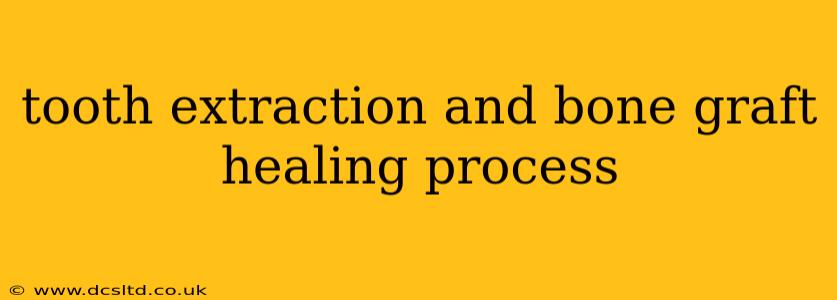Losing a tooth can be a significant event, impacting both your smile and your oral health. While tooth extraction is often necessary, it can lead to bone loss in the jaw. This is where bone grafting comes in. This comprehensive guide will explore the healing process following tooth extraction and bone grafting, addressing common questions and concerns.
What Happens After a Tooth Extraction?
The immediate post-extraction period focuses on managing bleeding and minimizing discomfort. Your dentist will place a gauze pad over the extraction site to control bleeding, which should subside within a few hours. Expect some swelling and bruising, and your dentist will likely prescribe pain medication. It's crucial to follow all post-operative instructions meticulously, including avoiding rinsing vigorously, smoking, and using a straw, as these can dislodge the blood clot that forms, potentially leading to a painful complication called "dry socket." The initial healing involves the formation of a blood clot, which acts as a foundation for new bone and gum tissue growth. This stage typically takes about a week.
What is a Bone Graft and Why is it Necessary?
A bone graft is a surgical procedure where bone tissue is placed into the extraction site to stimulate bone regeneration. This is often necessary because after tooth extraction, the jawbone begins to resorb (break down) due to the lack of stimulation from the tooth root. Insufficient bone volume can prevent the placement of dental implants later on, making a bone graft crucial for long-term success. Bone grafts can utilize various materials, including your own bone (autograft), bone from a donor (allograft), or synthetic bone substitutes.
How Long Does it Take for a Bone Graft to Heal?
The healing time for a bone graft varies depending on the type of graft, the size of the defect, and individual patient factors. Generally, it takes several months for the grafted bone to integrate with the surrounding jawbone. Complete healing and bone remodeling can take up to a year or more. Regular follow-up appointments with your dentist or oral surgeon are essential to monitor healing progress and address any potential complications. X-rays are often used to assess bone growth and integration.
What are the signs of infection after a bone graft?
Signs of infection after a bone graft can include increased pain, swelling, redness, pus, or fever. If you experience any of these, contact your dentist or oral surgeon immediately. Prompt treatment is vital to prevent serious complications.
What are the potential complications of a bone graft?
While bone grafting is generally a safe and effective procedure, potential complications include infection, nerve damage, graft resorption (graft failure), and sinus perforation (if the graft is near the sinuses). These complications are relatively uncommon, and your dentist or oral surgeon will discuss the risks before the procedure.
Can I get dental implants after a bone graft?
Yes, the primary purpose of a bone graft is often to prepare the jawbone for dental implants. Once the bone graft has healed sufficiently, usually after several months, your dentist or oral surgeon can place dental implants into the grafted site. This allows for the restoration of a missing tooth with a permanent, natural-looking replacement.
How do I care for the extraction site after a bone graft?
Post-operative care for a bone graft is similar to that after a tooth extraction, emphasizing meticulous oral hygiene. Your dentist will provide specific instructions, which may include gentle rinsing, avoiding smoking, and adhering to a prescribed medication regimen. Regular follow-up appointments are crucial for monitoring healing and ensuring optimal outcomes.
What are the different types of bone grafts?
There are various types of bone grafts, including autografts (taken from your own body), allografts (from a donor), and xenografts (from an animal source). Synthetic bone substitutes are also available. Your dentist or oral surgeon will determine the best type of bone graft for your individual needs based on several factors.
By understanding the tooth extraction and bone graft healing process, you can approach the procedure with greater confidence and ensure optimal outcomes. Remember that consistent communication with your dentist or oral surgeon throughout the healing period is essential for successful recovery.
